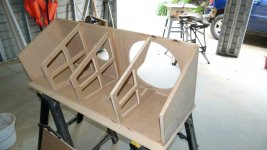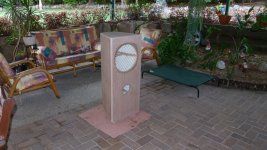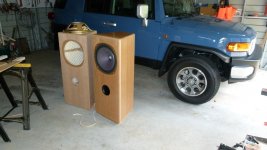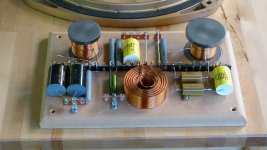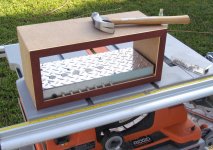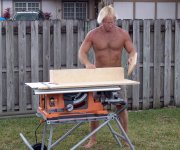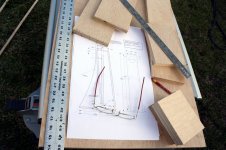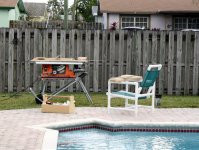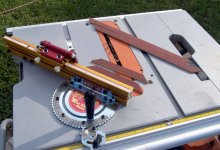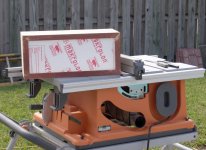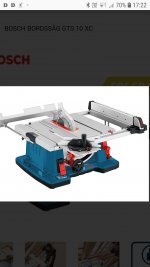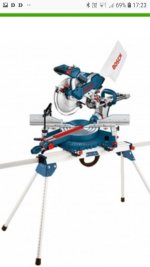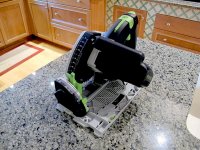I have done a search but didn't come up with much that specifically addresses this...
I have decent circular and miter saws, and use material-appropriate quality blades. I also have a couple of clamp edges for cutting straight lines. This has been good enough for e.g. shelves, trim, general household stuff.
With an eye to building speaker boxes, I am looking at table saws. It seems like there is a huge jump in price (and weight, and shop space required!) from the portable "worksite" saws to the "serious woodworking" ones.
While I don't plan to start there, I like the utilitarian look of TG's speakers in baltic birch, for example, but that type of construction (miter joints and transparent finish) demands a level of accuracy. There's no hiding gaps in those!
Is a good quality worksite saw like the Bosch 4100-10 good enough, or can it be dialed in to be good enough, for building moderately sized speaker boxes in that fashion?
Or from another angle - is something like the Bosch 4100-10 even a worthwhile upgrade from a good circular saw with a decent guide and blade?
I have decent circular and miter saws, and use material-appropriate quality blades. I also have a couple of clamp edges for cutting straight lines. This has been good enough for e.g. shelves, trim, general household stuff.
With an eye to building speaker boxes, I am looking at table saws. It seems like there is a huge jump in price (and weight, and shop space required!) from the portable "worksite" saws to the "serious woodworking" ones.
While I don't plan to start there, I like the utilitarian look of TG's speakers in baltic birch, for example, but that type of construction (miter joints and transparent finish) demands a level of accuracy. There's no hiding gaps in those!
Is a good quality worksite saw like the Bosch 4100-10 good enough, or can it be dialed in to be good enough, for building moderately sized speaker boxes in that fashion?
Or from another angle - is something like the Bosch 4100-10 even a worthwhile upgrade from a good circular saw with a decent guide and blade?
Last edited:
I've been using a dewalt jobsite saw and it made it vastly easier than a circular saw. To be fair, I haven't used miter joints, so I can't speak to that, but you could consider using a router with a chamfer bit for that too.
I have this one: https://www.homedepot.com/p/RIDGID-15-Amp-Corded-10-in-Heavy-Duty-Portable-Table-Saw-with-Stand-R4513/100090444
It has a nice fence that is reliably accurate, and is easy to store and set up. My ONLY minor complaint is the 45 degree miter stop isn't totally accurate, so it needs to be double checked before cutting miters. Other than that it's been a great tool for my speaker building hobby and everything else.
Mike
It has a nice fence that is reliably accurate, and is easy to store and set up. My ONLY minor complaint is the 45 degree miter stop isn't totally accurate, so it needs to be double checked before cutting miters. Other than that it's been a great tool for my speaker building hobby and everything else.
Mike
Around here you can often find a used cabinet saw on Craigslist for around the same $500 mark, with the biggest advantage being that weight and size make it more stable and therefore more accurate, especially when cutting big sheets. You may also find that you use a dado blade often once you have a saw that can run it. But, having something new means you're not inheriting someone else's wear and dings, and most of the contractor saws in the $500 range are a huge step up from using a circular saw.
There are also a new breed of "hybrid" saws, that resemble cabinet saws but are a bit smaller like a contractor saw that can be had for under $1000 - check out Shop Tools and Machinery at Grizzly.com for example.
Good luck with your search,
John
There are also a new breed of "hybrid" saws, that resemble cabinet saws but are a bit smaller like a contractor saw that can be had for under $1000 - check out Shop Tools and Machinery at Grizzly.com for example.
Good luck with your search,
John
Last edited:
As we all know, with tools more than anything, you get what you pay for!
The first question to ask yourself is how much room do you have for a table saw? Does it need to stow away on a shelf or in the corner when not in use. After that buy the most expensive one in your budget... you won't regret it. Plus investing a large sum of $$$ will (should) motivate you to use it more.
With a table saw a sturdy (accurate) rip-fence and the largest off-feed table that you can justify are key.
Just remember Safety First with a table saw... when they bite you they bite hard!
Dave
The first question to ask yourself is how much room do you have for a table saw? Does it need to stow away on a shelf or in the corner when not in use. After that buy the most expensive one in your budget... you won't regret it. Plus investing a large sum of $$$ will (should) motivate you to use it more.
With a table saw a sturdy (accurate) rip-fence and the largest off-feed table that you can justify are key.
Just remember Safety First with a table saw... when they bite you they bite hard!
Dave
Appreciate the advice, all! That's a really useful spectrum of experience.
John - I was not aware of the "hybrid" class of saws. I had seen the "higher end" worksite saws and then a jump up to the $2,000+ range. I just showed my partner the price of that Grizzly and wasn't met with complete incredulity, so perhaps...
And re safety, yes, I am terrified of pretty much all my power tools and have read bad things about tablesaws. I try to be scrupulously safety conscious and avoid complacency...
John - I was not aware of the "hybrid" class of saws. I had seen the "higher end" worksite saws and then a jump up to the $2,000+ range. I just showed my partner the price of that Grizzly and wasn't met with complete incredulity, so perhaps...
And re safety, yes, I am terrified of pretty much all my power tools and have read bad things about tablesaws. I try to be scrupulously safety conscious and avoid complacency...
I am terrified of pretty much all my power tools
That's not necessary...most "accidents" come from hurrying and getting careless. I've been using potentially dangerous power tools for 50 years, I've never had any injury worse than a scrape or anything requiring more than a band-aid. Just read and follow the manufactures instructions, double check your set-ups, make sure everything is clear of blades, bits, and other whirligigs...AND DON'T RUSH! "Go fever" is the main cause of all tragedies.
Mike
I recently bought a DeWalt DW-745 and don't regret it.
DeWALT 1850W 254mm Table Saw | Bunnings Warehouse
The fence is geared and very accurate and the mitre angles are spot on. I check with an inclinometer but it is dead on every time.
I didn't have the space or the $$$ for a cabinet saw (tools are expensive here compared to US), nor able to justify it for hobby use. This one fit the bill just right for me.
My experience only, yours might be different 🙂
As for power tool terror, I personally keep a healthy fear of all live tools. Always be calm, collected and alert when using a TS.
DeWALT 1850W 254mm Table Saw | Bunnings Warehouse
The fence is geared and very accurate and the mitre angles are spot on. I check with an inclinometer but it is dead on every time.
I didn't have the space or the $$$ for a cabinet saw (tools are expensive here compared to US), nor able to justify it for hobby use. This one fit the bill just right for me.
My experience only, yours might be different 🙂
As for power tool terror, I personally keep a healthy fear of all live tools. Always be calm, collected and alert when using a TS.
I totally agree , just think what you're doing , know your tools . measure twice or more and use sharp blades . I managed to build ALOT of things with an old Ryobi tables saw bought for $247 NZealand dollars in 2003 . I used it to renovate my house in Rotorua and cut firewood with it for 2 years . In 2005 when we moved to Australia I build this lovely Tannoys with the Ryobi . I still use it today , but bearings are a bit gone , parts still available online for cheap !That's not necessary...most "accidents" come from hurrying and getting careless. I've been using potentially dangerous power tools for 50 years, I've never had any injury worse than a scrape or anything requiring more than a band-aid. Just read and follow the manufactures instructions, double check your set-ups, make sure everything is clear of blades, bits, and other whirligigs...AND DON'T RUSH! "Go fever" is the main cause of all tragedies.
Mike
Enjoining the Tannoys every day !
Cheers ,
Rens
Attachments
Yes, perhaps "terrified" is overstating it slightly. 🙂That's not necessary...most "accidents" come from hurrying and getting careless.
But I'm acutely aware that these things could easily eat a finger if allowed to get away (and I have about 10% of your experience with them). I am good with working slowly, staying clear of blades and bits etc. It's the accident modes where the tool comes after you - binding, kickback, wheels disintegrating etc. I realize those risks can all be mitigated too with good practices.
Those Tannoys are magnificent!
I've been contemplating the same things for a while now as well. Originally I considered holding out until I found a nice cabinet saw for a home shop.
The home shop hasn't happened, and am considering more portable/flexible setups. I was using a Dewalt Circular saw for big cuts when a jobsite table saw I borrowed wasn't big enough. Used a homemade rip board with the circular that gave pretty good results for cross cutting long pieces, and especially Open Baffle work. Dust was a bit of an issue which lead me to believe this would only be temporary.
The gents at the tool shop suggested a track saw. I had always been interested in them, as it affords you lots of flexibility and more precision cuts than the typical rip board with a circular saw. The dust collection issue I was told could be solved by using a good vac on the saw side itself, and placing the cut material on top of an XPS sheet, which prevents the dust from blowing out the bottom. Also may help with tear out.
If you're considering not going with a table based saw, and have the ability, the track saw is worth a look. Makita makes a nice one that isn't too rich. They don't do everything a table saw does, but for bigger projects, it could be better than an undersized table saw in some ways.
If the track saw seems too pricey, and you're considering a circular saw, there are a few products that allow a circular saw to be converted to a track saw, as well as some DIY videos/articles that show how one can make their own track.
The home shop hasn't happened, and am considering more portable/flexible setups. I was using a Dewalt Circular saw for big cuts when a jobsite table saw I borrowed wasn't big enough. Used a homemade rip board with the circular that gave pretty good results for cross cutting long pieces, and especially Open Baffle work. Dust was a bit of an issue which lead me to believe this would only be temporary.
The gents at the tool shop suggested a track saw. I had always been interested in them, as it affords you lots of flexibility and more precision cuts than the typical rip board with a circular saw. The dust collection issue I was told could be solved by using a good vac on the saw side itself, and placing the cut material on top of an XPS sheet, which prevents the dust from blowing out the bottom. Also may help with tear out.
If you're considering not going with a table based saw, and have the ability, the track saw is worth a look. Makita makes a nice one that isn't too rich. They don't do everything a table saw does, but for bigger projects, it could be better than an undersized table saw in some ways.
If the track saw seems too pricey, and you're considering a circular saw, there are a few products that allow a circular saw to be converted to a track saw, as well as some DIY videos/articles that show how one can make their own track.
I have this one: https://www.homedepot.com/p/RIDGID-1...4513/100090444
I have the same saw and have used it for nearly 10 years. I was lucky enough to get mine for $279 on a Black Friday sale.
It can be folded up and stuffed into a corner of the garage, and it does a decent job. I got a $100 INCRA from Amazon for miter corners on faceplates. Does it work as good as the 5 HP monster in the wood shop at school? No. Does the quality of work that an average craftsman like myself get out of it compare with the work I got from the school saw? Yes.
Attachments
Lots of good advice here, but I'll add some opinions as well.
- A circular saw is the wrong tool, even with a guide. The diameter of the saw arbour (shaft) in an average circular saw is too small and hence not stiff enough to give a good result. Good for framing but requires a lot of experience to get a good result.
- A track saw will do the job (I have a German-made track saw that I dearly love for cabinet work), but they can be tricky for long mitre cuts, and can be *pricey*, so perhaps not the tool to buy unless you have other work for it.
- A decent quality job-site saw (i.e. Bosch, DeWalt, etc) will be fine if you take the time to dial it in well. Don't be afraid to spend $100 upgrading the blade to one specifically made for laminates like birch plywood - you will get a better result than the "generalist" blade that will come with the saw.
-k-
- A circular saw is the wrong tool, even with a guide. The diameter of the saw arbour (shaft) in an average circular saw is too small and hence not stiff enough to give a good result. Good for framing but requires a lot of experience to get a good result.
- A track saw will do the job (I have a German-made track saw that I dearly love for cabinet work), but they can be tricky for long mitre cuts, and can be *pricey*, so perhaps not the tool to buy unless you have other work for it.
- A decent quality job-site saw (i.e. Bosch, DeWalt, etc) will be fine if you take the time to dial it in well. Don't be afraid to spend $100 upgrading the blade to one specifically made for laminates like birch plywood - you will get a better result than the "generalist" blade that will come with the saw.
-k-
I've got Bosch GTS 10 and GCM 10.
Works great with perfect precision, but I always doublecheck
When cutting angles.
The tablesaw is built in to a bench so I will be able to cut whole boards 2.40x1.20 m without problems.
Figge
Forgot to say that 60 or 80 teeth blades cuts nice !
Works great with perfect precision, but I always doublecheck
When cutting angles.
The tablesaw is built in to a bench so I will be able to cut whole boards 2.40x1.20 m without problems.
Figge
Forgot to say that 60 or 80 teeth blades cuts nice !
Attachments
Last edited:
I have the same saw and have used it for nearly 10 years. I was lucky enough to get mine for $279 on a Black Friday sale.
It can be folded up and stuffed into a corner of the garage, and it does a decent job. I got a $100 INCRA from Amazon for miter corners on faceplates. Does it work as good as the 5 HP monster in the wood shop at school? No. Does the quality of work that an average craftsman like myself get out of it compare with the work I got from the school saw? Yes.
My only complaint is the miter stop is inconsistent, sometimes it will set correctly at 45 degrees, and sometimes not...it shifts off position when I tighten the clamp lever. Do you have that issue? Other than that I love it.
Oh yeah, about radial arm saws...I used a friend's once...I found it limited in capacity, and cumbersome to use.
Mike
Last edited:
You can find a 1980's or earlier vintage US made Delta Unisaw or Contractor's table saw for a few hundred dollars. It might take $50 worth of bearings and belts and some cleanup and adjustments to make it run better than anything you could buy now for under $2500+. Go to Old Woodworking Machines - Index page for all the tutoring you could want.
- Status
- Not open for further replies.
- Home
- Design & Build
- Equipment & Tools
- "Good enough" table saw for speakers
